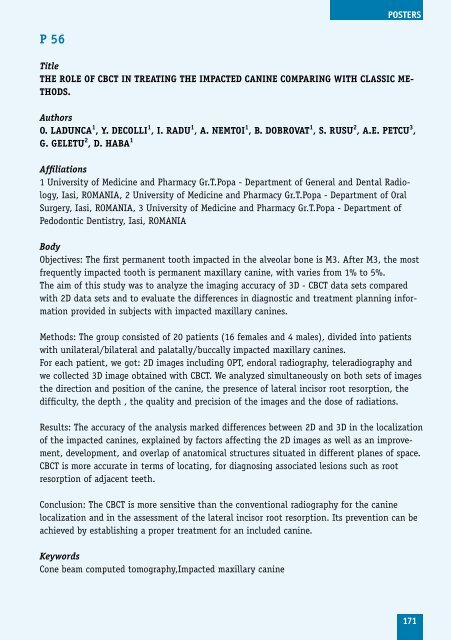Program including abstracts as pdf available here
Program including abstracts as pdf available here
Program including abstracts as pdf available here
Create successful ePaper yourself
Turn your PDF publications into a flip-book with our unique Google optimized e-Paper software.
P 56<br />
Title<br />
THE ROLE OF CbCT IN TREATING THE IMPACTED CANINE COMPARING WITH CLASSIC ME-<br />
THODS.<br />
Authors<br />
O. LADuNCA 1 , y. DECOLLI 1 , I. RADu 1 , A. NEMTOI 1 , b. DObROVAT 1 , S. RuSu 2 , A.E. PETCu 3 ,<br />
G. GELETu 2 , D. HAbA 1<br />
Affiliations<br />
1 University of Medicine and Pharmacy Gr.T.Popa - Department of General and Dental Radiology,<br />
I<strong>as</strong>i, ROMANIA, 2 University of Medicine and Pharmacy Gr.T.Popa - Department of Oral<br />
Surgery, I<strong>as</strong>i, ROMANIA, 3 University of Medicine and Pharmacy Gr.T.Popa - Department of<br />
Pedodontic Dentistry, I<strong>as</strong>i, ROMANIA<br />
Body<br />
Objectives: The first permanent tooth impacted in the alveolar bone is M3. After M3, the most<br />
frequently impacted tooth is permanent maxillary canine, with varies from 1% to 5%.<br />
The aim of this study w<strong>as</strong> to analyze the imaging accuracy of 3D - CBCT data sets compared<br />
with 2D data sets and to evaluate the differences in diagnostic and treatment planning information<br />
provided in subjects with impacted maxillary canines.<br />
Methods: The group consisted of 20 patients (16 females and 4 males), divided into patients<br />
with unilateral/bilateral and palatally/buccally impacted maxillary canines.<br />
For each patient, we got: 2D images <strong>including</strong> OPT, endoral radiography, teleradiography and<br />
we collected 3D image obtained with CBCT. We analyzed simultaneously on both sets of images<br />
the direction and position of the canine, the presence of lateral incisor root resorption, the<br />
difficulty, the depth , the quality and precision of the images and the dose of radiations.<br />
Results: The accuracy of the analysis marked differences between 2D and 3D in the localization<br />
of the impacted canines, explained by factors affecting the 2D images <strong>as</strong> well <strong>as</strong> an improvement,<br />
development, and overlap of anatomical structures situated in different planes of space.<br />
CBCT is more accurate in terms of locating, for diagnosing <strong>as</strong>sociated lesions such <strong>as</strong> root<br />
resorption of adjacent teeth.<br />
Conclusion: The CBCT is more sensitive than the conventional radiography for the canine<br />
localization and in the <strong>as</strong>sessment of the lateral incisor root resorption. Its prevention can be<br />
achieved by establishing a proper treatment for an included canine.<br />
Keywords<br />
Cone beam computed tomography,Impacted maxillary canine<br />
POSTerS<br />
171


